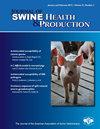与母猪产后泌乳不良综合征相关的大肠杆菌阴道分离株的毒力基因
IF 0.7
4区 农林科学
Q3 Agricultural and Biological Sciences
引用次数: 0
摘要
目的:确定与母猪产后泌乳不良综合征(PDS)相关的大肠杆菌阴道分离株的某些毒力基因的发生情况。材料与方法:对5个马其顿猪场的122头母猪进行产后12 ~ 24小时PDS临床检查。从感染pds (PDSA, n = 47)和未感染pds (PDSU, n = 155)的母猪身上取阴道拭子进行细菌学检测。采用多重聚合酶链反应法检测74株大肠杆菌是否存在与特定致病菌株相关的毒力基因。结果:与肠外致病性大肠杆菌(ExPEC)菌株相关的基因在所有检测的大肠杆菌分离株中最为普遍。所有大肠杆菌分离株中最显性基因为fimC。与PDSU母猪相比,iss基因在PDSA母猪中更为普遍(P = 0.02)。多变量logistic回归分析显示,低胎次母猪(P≤0.001)、iss基因(P = 0.003)和astA基因(P = 0.03)的存在与PDS的发生相关。结论:低胎次的母猪阴道感染与特定的大肠杆菌菌株相关的大肠杆菌,发生PDS的风险更高。分娩后早期阴道棉签中大肠杆菌和iss基因阳性与母猪PDS有关。仅通过毒力基因分型无法将大肠杆菌分类为特定的expc致病型。本文章由计算机程序翻译,如有差异,请以英文原文为准。
Virulence genes of Escherichia coli vaginal isolates associated with postpartum dysgalactia syndrome in sows
Objective: Identify the occurrence of certain virulence genes of Escherichia coli vaginal isolates associated with postpartum dysgalactia syndrome (PDS) in sows. Materials and methods: Two hundred and two sows from 5 Macedonian pig farms were clinically examined for PDS 12 to 24 hours after farrowing. Vaginal swabs for bacteriological testing were taken from PDS-affected (PDSA, n = 47) and PDS-unaffected (PDSU, n = 155) sows. In total, 74 isolates of E coli were tested by multiplex polymerase chain reaction for the presence of virulence genes related to specific pathogenic strains. Results: Genes associated with extra-intestinal pathogenic E coli (ExPEC) strains were the most prevalent among all tested E coli isolates. The most dominant gene among all E coli isolates was fimC. The iss gene was more prevalent in PDSA sows compared to PDSU sows (P = .02). Multivariable logistic regression showed that lower parity sows (P ≤ .001) and presence of the iss (P = .003) and astA genes (P = .03) were correlated with the occurrence of PDS. Implications: Lower parity sows vaginally infected with E coli associated with particular ExPEC strains are at higher risk of developing PDS. Positive vaginal swabs for E coli and iss gene found early after farrowing were associated with PDS in sows. Classification of E coli into specific ExPEC pathotype was not possible by virulence genotyping only.
求助全文
通过发布文献求助,成功后即可免费获取论文全文。
去求助
来源期刊
CiteScore
1.80
自引率
0.00%
发文量
29
审稿时长
>36 weeks
期刊介绍:
The Journal of Swine Health & Production (JSHAP) is an open-access and peer-reviewed journal published by the American Association of Swine Veterinarians (AASV) since 1993. The aim of the journal is the timely publication of peer-reviewed papers with a scope that encompasses the many domains of applied swine health and production, including the diagnosis, treatment, management, prevention and eradication of swine diseases, welfare & behavior, nutrition, public health, epidemiology, food safety, biosecurity, pharmaceuticals, antimicrobial use and resistance, reproduction, growth, systems flow, economics, and facility design. The journal provides a platform for researchers, veterinary practitioners, academics, and students to share their work with an international audience. The journal publishes information that contains an applied and practical focus and presents scientific information that is accessible to the busy veterinary practitioner as well as to the research and academic community. Hence, manuscripts with an applied focus are considered for publication, and the journal publishes original research, brief communications, case reports/series, literature reviews, commentaries, diagnostic notes, production tools, and practice tips. All manuscripts submitted to the Journal of Swine Health & Production are peer-reviewed.

 求助内容:
求助内容: 应助结果提醒方式:
应助结果提醒方式:


